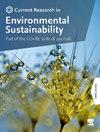Forest product market conditions mediate the scale and benefits of sustainable forest management in the Tahoe-Central Sierra Region
IF 3.8
Q2 ENVIRONMENTAL SCIENCES
Current Research in Environmental Sustainability
Pub Date : 2025-01-01
DOI:10.1016/j.crsust.2025.100296
引用次数: 0
Abstract
Forests in the Western United States face escalating threats from wildfire, pest outbreaks, and drought, leading experts and policymakers to call for extensive forest management to promote forest resilience and reduce wildfire risk. High treatment costs represent a major choke point to achieving forest management goals, but selling timber and biomass from forest thinning can offset costs and provide the revenue to help rapidly scale management actions. In this study, we assess how forest product market conditions influence the economic feasibility and scale of forest management by modeling treatment potential across a Northern Sierra Nevada landscape using the US Forest Service's BioSum tool. We evaluate treatment outcomes across nine economic scenarios, incorporating wood and biomass price variations and treatment subsidies. Results indicate that baseline pricing assumptions facilitate aggressive forest treatment where thinning is feasible and needed, but a 50 % drop in forest product prices led to a one-third decline in treated area. These reductions are completely offset by a $500/acre treatment subsidy, suggesting that subsidies could serve as a ‘price floor’ to maintain treatment levels through market fluctuations. Optimal, cost-effective treatments overwhelmingly utilized prescribed fire following thinning, emphasizing the role of fire-inclusive approaches for forest treatment. While study findings indicate that forest product markets can support landscape-scale treatments, the capacity of regional processing facilities currently limits full utilization of forest products, underscoring the importance of expanding wood and biomass utilization infrastructure to realize the potential of market-driven strategies for improving forest resilience in the Sierra Nevada and similar fire-prone regions.
在太浩-中塞拉地区,林产品市场条件决定了可持续森林管理的规模和效益
美国西部的森林面临着野火、虫害爆发和干旱日益加剧的威胁,专家和政策制定者呼吁进行广泛的森林管理,以提高森林的恢复能力,减少野火风险。高昂的处理费用是实现森林管理目标的主要瓶颈,但出售森林间伐产生的木材和生物质可以抵消成本,并提供收入,帮助迅速扩大管理行动。在本研究中,我们使用美国林务局的BioSum工具,通过模拟内华达山脉北部景观的处理潜力,评估了林产品市场条件如何影响森林管理的经济可行性和规模。我们评估了9种经济情景下的处理结果,包括木材和生物质价格变化和处理补贴。结果表明,基线定价假设有助于在可行且需要间伐的地方进行积极的森林治理,但林产品价格下降50%导致处理面积下降三分之一。每英亩500美元的处理补贴完全抵消了这些减少,这表明补贴可以作为“价格底线”,在市场波动时维持处理水平。最佳的、具有成本效益的处理方法绝大多数使用疏伐后的规定火,强调了包括火在内的方法在森林处理中的作用。虽然研究结果表明,林产品市场可以支持景观规模的处理,但区域加工设施的能力目前限制了林产品的充分利用,强调了扩大木材和生物质利用基础设施的重要性,以实现市场驱动战略的潜力,以提高内华达山脉和类似火灾易发地区的森林复原力。
本文章由计算机程序翻译,如有差异,请以英文原文为准。
求助全文
约1分钟内获得全文
求助全文
来源期刊

Current Research in Environmental Sustainability
Environmental Science-General Environmental Science
CiteScore
7.50
自引率
9.10%
发文量
76
审稿时长
95 days
 求助内容:
求助内容: 应助结果提醒方式:
应助结果提醒方式:


